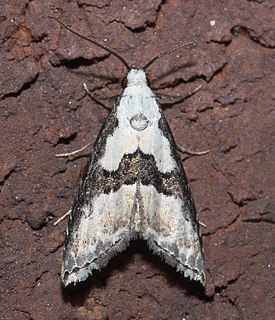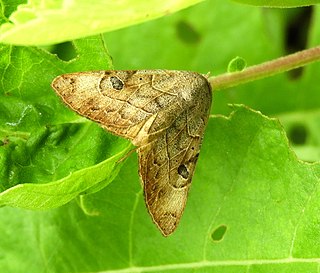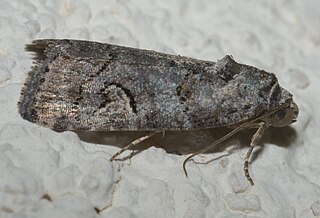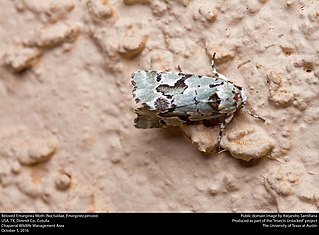
The Noctuidae, commonly known as owlet moths, cutworms or armyworms, are the most controversial family in the superfamily Noctuoidea because many of the clades are constantly changing, along with the other families of the Noctuoidea. It was considered the largest family in Lepidoptera for a long time, but after regrouping Lymantriinae, Catocalinae and Calpinae within the family Erebidae, the latter holds this title now. Currently, Noctuidae is the second largest family in Noctuoidea, with about 1,089 genera and 11,772 species. However, this classification is still contingent, as more changes continue to appear between Noctuidae and Erebidae.

Amphipyrinae is a subfamily of owlet moths in the family Noctuidae. There are more than 50 genera and 210 described species in Amphipyrinae, although the classifications are likely to change over time.

Isogona is a genus of moths of the family Erebidae. The genus was erected by Achille Guenée in 1852.

Nigetia is a monotypic moth genus in the family Erebidae. Its only species, Nigetia formosalis, the thin-winged algibelle or thin-winged owlet moth, has a scattered distribution in eastern North America from Ontario to Connecticut, south to Florida and Texas. Both the genus and the species were first described by Francis Walker in 1866.

Schinia sordida, the sordid flower moth or dingy schinia, is a moth of the family Noctuidae. The species was first described by John B. Smith in 1883. It is found in the United States from North Carolina to central Florida west to Kansas and Texas. It has also been recorded from Alabama.

Phalaenophana pyramusalis, the dark-banded owlet, is a moth of the family Erebidae. The species was first described by Francis Walker in 1859. It is found in North America from Saskatchewan to Nova Scotia, south to North Carolina and Texas.

Phalaenostola larentioides, the black-banded owlet, is a moth of the family Erebidae. The species was first described by Augustus Radcliffe Grote in 1873. It is found in North America from New Brunswick and Wisconsin to Maine, south to Florida and Texas, west to Ontario.
Phalaenostola hanhami, also called Hanham's owlet or Hanham's snout moth, is a litter moth of the family Erebidae. The species was first described by J. B. Smith in 1899. It is found in North America from Nova Scotia, west across Canada to central Alberta, south to Massachusetts and New York.

Tetanolita floridana, the Florida owlet or Florida tetanolita moth, is a litter moth of the family Erebidae. The species was first described by J. B. Smith in 1895. It is found in the United States from Wisconsin to Long Island, south to Florida and Texas.

Isogona tenuis, the thin-lined owlet, is a moth of the family Erebidae. The species was first described by Augustus Radcliffe Grote in 1872. It is found from Ontario, Wisconsin, Ohio and New Jersey, south to Florida and Texas.

Isogona scindens is a species of moth of the family Erebidae first described by Francis Walker in 1858. It is found from the southern parts of the United States to Paraguay and on Saint Kitts, Antigua, Grenada, Jamaica, Cuba, Hispaniola and Saint Croix.
Isogona segura is a species of moth of the family Erebidae first described by William Barnes in 1907. It is found in the US state of Arizona.
Spargaloma is a monotypic moth genus in the family Erebidae. Its only species is Spargaloma sexpunctata, the six-spotted gray. Both the genus and species were first described by Augustus Radcliffe Grote in 1873. It is found from coast to coast in lower Canada south in the east to Florida, Mississippi and Arkansas, in the west to California.
Mamestra curialis, the scripted arches, is a moth in the family Noctuidae described by John Bernhard Smith in 1887. It is found in North America.

Stiriini is a tribe of owlet moths in the family Noctuidae. There are about 16 genera and more than 90 described species in Stiriini.
Noctuini is a tribe of owlet moths in the family Noctuidae. There are at least 520 described species in Noctuini.

Triocnemidina is a subtribe of owlet moths in the family Noctuidae. There are about 16 genera and at least 30 described species in Triocnemidina.

Psaphidini is a tribe of owlet moths in the family Noctuidae. There are at least 40 genera and at least 90 described species in Psaphidini.
Xeracris snowi, or Snow's desert grasshopper, is a species of slant-faced grasshopper in the family Acrididae. It is found in Central America and North America.
Paratrytone snowi, or Snow's skipper, is a species of grass skipper in the butterfly family Hesperiidae.













